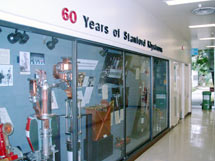
Handy Links
SLAC News Center
SLAC Today
- Subscribe
- Archives: Feb 2006-May 20, 2011
- Archives: May 23, 2011 and later
- Submit Feedback or Story Ideas
- About SLAC Today
SLAC News
Lab News
- Interactions
- Lightsources.org
- ILC NewsLine
- Int'l Science Grid This Week
- Fermilab Today
- Berkeley Lab News
- @brookhaven TODAY
- DOE Pulse
- CERN Courier
- DESY inForm
- US / LHC
SLAC Links
- Emergency
- Safety
- Policy Repository
- Site Entry Form

- Site Maps
- M & O Review
- Computing Status & Calendar
- SLAC Colloquium
- SLACspeak
- SLACspace
- SLAC Logo
- Café Menu
- Flea Market
- Web E-mail
- Marguerite Shuttle
- Discount Commuter Passes
-
Award Reporting Form
- SPIRES
- SciDoc
- Activity Groups
- Library
Stanford
Around the Bay
SLAC's Klystron Legacy
 On January 30, 1939, the Palo Alto Times published the headline, "New Stanford Invention Heralds Revolutionary Changes." Sixty-nine years have passed and "revolutionary" still encapsulates the klystron's legacy. A museum-worthy display in Building 44's Klystron & Microwave Department chronicles the device's history through photographs, descriptions and genuine pieces of the technology.
On January 30, 1939, the Palo Alto Times published the headline, "New Stanford Invention Heralds Revolutionary Changes." Sixty-nine years have passed and "revolutionary" still encapsulates the klystron's legacy. A museum-worthy display in Building 44's Klystron & Microwave Department chronicles the device's history through photographs, descriptions and genuine pieces of the technology.
A klystron is an electron tube that converts electricity into microwaves for applications as diverse as radar, cancer treatment, broadcast television transmission and, of course, particle acceleration.
"The klystron is the radio frequency [RF] source of choice anywhere you need very high peak power and narrow bandwidth," engineer Glenn Scheitrum said. "Nothing will touch the klystron for the peak RF power levels needed in storage rings and accelerators."
In 1943, a small glass klystron called the CV-150 could produce 20 kilowatts of power for World War II radar applications. Six years later, Stanford researchers had created a klystron that could produce 20 megawatts of power. "This milestone in achievement enabled practical high gradient acceleration and led to the creation of SLAC," Scheitrum said.
In addition to being instrumental to running the PEP-II storage ring, the Stanford Synchrotron Radiation Laboratory's SPEAR storage ring and SLAC's linear accelerator, SLAC klystrons have found homes all over the world. Among those on display in the Klystron Department is an S-band klystron, built for DESY in Germany, that has the highest published pulse energy in a multi-megawatt klystron.
Another more recent SLAC development is the X-band klystron, which is in great demand from international laboratories.
"In terms of high-power klystrons for accelerator operations, we've always been right at the forefront of RF source development," said Chris Pearson, head of the Klystron Department.
—Matt Cunningham, SLAC Today, January 24, 2008
Above image: SLAC's klystron display, located in the lobby of Building 44. (Click image for larger version.)